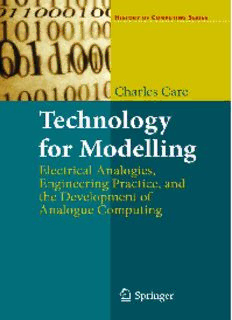Table Of ContentHistory of Computing
SeriesEditor
MartinCampbell-Kelly,UniversityofWarwick,Coventry,UK
AdvisoryBoard
GerardAlberts,UniversityofAmsterdam,Amsterdam,TheNetherlands
JackCopeland,UniversityofCanterbury,Christchurch,NewZealand
UlfHashagen,DeutschesMuseum,Munich,Germany
JohnV.Tucker,SwanseaUniversity,Swansea,UK
JeffreyR.Yost,UniversityofMinnesota,Minneapolis,USA
TheHistoryofComputingseriespublisheshigh-qualitybookswhichaddressthehistoryofcomputing,
withanemphasis onthe‘externalist’ viewofthis history, more accessibletoawideraudience.The
seriesexaminescontentandhistoryfromfourmainquadrants:thehistoryofrelevanttechnologies,the
historyofthecorescience,thehistoryofrelevantbusinessandeconomicdevelopments,andthehistory
ofcomputingasitpertainstosocialhistoryandsocietaldevelopments.
Titlescanspanavarietyofproducttypes,includingbutnotexclusively,themedvolumes,biographies,
‘profile’books(withbriefbiographiesofanumberofkeypeople),expansionsofworkshopproceedings,
generalreaders,scholarlyexpositions,titlesusedasancillarytextbooks,revivalsandneweditionsof
previousworthytitles.
Thesebookswillappeal,varyingly,toacademicsandstudentsincomputerscience,history,mathematics,
businessandtechnologystudies.Sometitleswillalsodirectlyappealtoprofessionalsandpractitioners
ofdifferentbackgrounds.
Authorguidelines:springer.com>Authors>AuthorGuidelines
Forothertitlespublishedinthisseries,gotohttp://www.springer.com/series/8442
Charles Care
Technology
for Modelling
Electrical Analogies,
Engineering Practice, and
the Development of
Analogue Computing
Dr.CharlesCare
Dept.ComputerScience
UniversityofWarwick
CoventryCV47AL
UK
c.care@warwick.ac.uk
ISBN978-1-84882-947-3 e-ISBN978-1-84882-948-0
DOI10.1007/978-1-84882-948-0
SpringerLondonDordrechtHeidelbergNewYork
BritishLibraryCataloguinginPublicationData
AcataloguerecordforthisbookisavailablefromtheBritishLibrary
LibraryofCongressControlNumber:2010930604
©Springer-VerlagLondonLimited2010
Apartfromanyfairdealingforthepurposesofresearchorprivatestudy,orcriticismorreview,asper-
mittedundertheCopyright,DesignsandPatentsAct1988,thispublicationmayonlybereproduced,
storedortransmitted,inanyformorbyanymeans,withthepriorpermissioninwritingofthepublish-
ers,orinthecaseofreprographicreproductioninaccordancewiththetermsoflicensesissuedbythe
CopyrightLicensingAgency.Enquiriesconcerningreproductionoutsidethosetermsshouldbesentto
thepublishers.
Theuseofregisterednames,trademarks,etc.,inthispublicationdoesnotimply,evenintheabsenceofa
specificstatement,thatsuchnamesareexemptfromtherelevantlawsandregulationsandthereforefree
forgeneraluse.
Thepublishermakesnorepresentation,expressorimplied,withregardtotheaccuracyoftheinformation
containedinthisbookandcannotacceptanylegalresponsibilityorliabilityforanyerrorsoromissions
thatmaybemade.
Coverdesign:eStudioCalamar
Printedonacid-freepaper
SpringerispartofSpringerScience+BusinessMedia(www.springer.com)
ForRachel
Preface
This book is based on research I undertook for my Ph.D. at the University of
Warwick. Its motivation began when, as an undergraduate, I completed a research
project on the history of planimeters and mechanicalintegrators.That project was
my first journey into the history of analogue computing, and left me with more
unansweredquestionsthanIstartedwith.Iwantedtounderstandtherelationshipbe-
tweenanalogueanddigitalcomputing,andwhatthatmeantforcontemporaryusers.
Ifounditfascinatingthatsomehistoriansportrayedanaloguecomputingsolelyasa
precursortodigital,whereasotherswerestressingthatanaloguecomputingexisted
wellafter1940.Earlyoninmyresearchitbecameclearthathistorianshaddifferent
views of the core identity of analogue computing. In fact, it quickly became evi-
dentthatevenwithincontemporarysources,therewasaspectrumofunderstanding
aroundwhatconstitutedanaloguecomputing.ItwasatthatpointIbeganrestructur-
ingthehistoryaroundhowthetechnologywasused.
This study investigates the technologies, the concepts, and the applications of
analoguecomputing.Itisarguedthatanaloguecomputingmustbethoughtofasnot
just a computing technology, but also as a modelling technology. The first half of
thebookdemonstrateshowthehistoryofanaloguecomputingcanbeunderstoodin
terms of the two parallel themes of calculation and modelling, and describes how
the technology evolved. The second half of the book focuses on a number of de-
tailedcasestudies:examininganaloguemodellinginacademicresearch,oilreser-
voir modelling, aeronautical design, and meteorology. Many of these case studies
discussso-called‘direct’analogues—analoguecomputersthatusedadirectphysi-
calanalogy.Becausetheywerenotusedascalculators,directanaloguesrarelyre-
ceiveprominenceincomputinghistory.However,theseweretheanaloguedevices
thatpersistedthelongest.
Exploring the history in the context of modelling technology encourages us to
see analogue computing in terms of its use. Rather than presenting analogue and
digitalasalternatives,thisapproachconsidersthemcomplementary.Thechallenge
istonotsimplyconsideranalogueanddigitalasseparatetechnologies,buttocon-
sider the continuity of practice that spanned the two. This practice was a practice
ofmodelling.Thisbookisnotthefirstaccounttoidentifyacloserelationshipbe-
tween analogue computing and modellingtechnology.That relationship is evident
vii
viii Preface
in the sources. However, it is my aim to bring that relationship to the forefront of
ourhistoriography.
The central thesis is to demonstrate that the history of analogue computing is
broaderthanjustthetechnologyorthemachines,butmustalsoincludehowitwas
usedandapplied.Whenwelookatthehistoryofanaloguecomputing,wefindthat
differentpeoplehaddifferentdefinitionsofwhatanaloguemeant.Manyhistoriesof
computinghavediscussedhistoricalepisodeswhenusersdebatedtherelativemerits
ofanalogueanddigital.However,thisbookproposesthatthese‘debates’shouldbe
framed around application rather than technology. Because the dominant applica-
tionsofanaloguecomputingwereasamodellingtechnology,thebookarguesthat
digital computing only became truly dominant once it too had become a practical
modellingtool.
Oxford,UK CharlesCare
Acknowledgements
Theresearchbehindthisbookistheresultofthreeyearsfull-timestudysupported
byaresearchscholarshipawardedbytheDepartmentofComputerScience,Univer-
sityofWarwick.Thegenesisofthethemeoriginatedinmyundergraduatedisserta-
tiononthehistoryofplanimeters,butthetopicresonateswithinterestsintechnol-
ogy,science,andmathematics,thatgobackmuchfurther.
Among the many who have offered insights, ideas, and encouragement, a few
names are salient. Dr. Steve Russ, my Ph.D. supervisor, has worked hard to guide
myreadingandwriting.Hehasfosteredinmyworkablendofphilosophy,history,
andcomputing,whichhasmadetheexperienceallthemoreenlightening.Similarly,
Prof.MartinCampbell-Kelly,hasalwaysprovidedexcellentadviceandsupport.
InteractionswithfellowresearchstudentsandacademicsatWarwickhavebeen
invaluable. Thanks go to Meurig Beynon, Steve Matthews, Russell Boyatt, Eric
Chan, Ant Harfield, Karl King, Dorian Rutter and Ashley Ward. Other historians
ofcomputingalsooffered supportandencouragement,specialthanksgotoDavid
Anderson,ChrisBissell,JanetDelve,JamesSumnerandDoronSwade.Acknowl-
edgement should also be made to Peter Housego and Joanne Burman of the BP
archives,JackieBishopandPaulLilleyatEMIArchives,andJaneWessattheSci-
enceMuseum.AlanCharlesworth,once‘SeniorHybridProgrammer’atUniversity
ofBath,agreedtobeinterviewed;andPaulCeruzzi,PeterLynch,andBrianRandell
providedhelpfulcorrespondence.
Also, I would like to formally acknowledge the librarians and archivists at the
followinginstitutions:LibraryandModernRecordsCentre,UniversityofWarwick;
TheBritishLibrary;BristolUniversityLibrary;ImperialCollegeLibrary;theRoyal
Society Library; the IET Library; The Bodleian Library; Birmingham Central Li-
brary;BirminghamUniversityLibrary;King’sCollegeLondonLibrary;University
of London Senate Library; Cambridge University Library; Manchester University
Library;andTheNationalArchives,Kew.
Inaddition,Iamindebtedtothepeopleandinstitutionswhohavegrantedpermis-
sion to reproduce quotations, images and photographs. Credits are acknowledged
throughoutthebook,butIamparticularlygratefultotheAssociationforComput-
ing Machinery, American Meteorological Society, BP Plc, Cambridge University
ix
x Acknowledgements
Press,EMIPlc,IEEE,theInstituteofPhysics,JohnsHopkinsUniversity,McGraw-
Hill, MIT Press, the Royal Society, the SAAB Corporation, and the University of
Chicago.ManythanksalsogotoWayneWheelerandSimonReesatSpringerVer-
lagwhohaveguidedmethroughtheprocessessurroundingpublication.
Finally,thisbookwouldneverhavereachedcompletionwithoutthesupportand
encouragement of my family and friends. My parents and sister have always sup-
ported my studies. However, special thanks are due to my wife Rachel, who has
livedalongsidethisresearch.She,likenoother,hasexperiencedtheupsanddowns
ofthisproject,andherongoingloveandsupportaredeeplytreasured.
Description:Historians have different views on the core identity of analogue computing. Some portray the technology solely as a precursor to digital computing, whereas others stress that analogue applications existed well after 1940. Even within contemporary sources, there is a spectrum of understanding around

